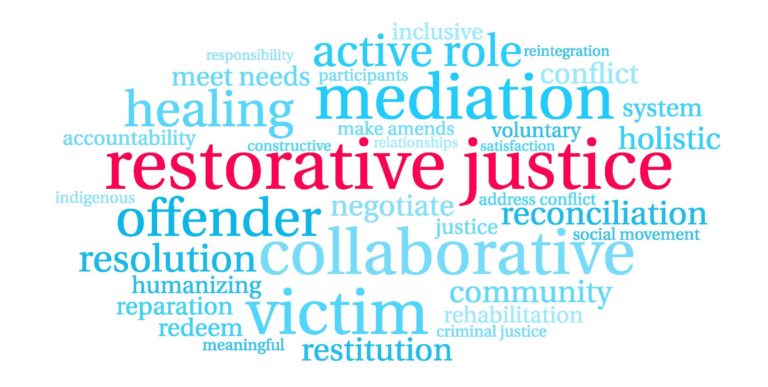A classroom teacher of any grade is challenged each year with the choice of conflict resolution or the best discipline plan to integrate with a daily classroom management style. It is not uncommon for teachers to alternate methods, as student population makeup varies each year. Once a teacher develops a successful conflict resolution method that allows students to learn with minimal distractions and creates a consistent classroom harmony, the teacher is more likely to use the same conflict resolution plan with a complimentary classroom management style each year. A conflict resolution widely valued by teachers is restorative justice.
What is Restorative Justice?
Restorative justice is a conflict resolution method that empowers school-aged children to solve problems on their own through discussions in small groups and/or mediation. Students are given the opportunity in their small groups to ask questions, air grievances without judgement, and are given an uninterrupted opportunity to express feelings. At the end of the discussion, students can discuss possible punishments that would be appropriate.
What are the Benefits of Restorative Justice?
The benefits of restorative justice with regard to childhood conflict in a classroom may include social skill lessons, building better future career attitudes, lessen classroom distractions, improve peer relationships, and cultivate a more tolerant classroom culture. These benefits all rely on one another.
Restorative justice focuses on repairing harm. The student involved in the conflict feels accepted by peers in the classroom to share their choices and actions that may or may not be facing a punishment. Students feel comfortable sharing and other students are ready to help peers work through the conflict. Through restorative justice, the students are learning to build relationships with one another as the teacher often mediates the group.
The final step achieved between the students involved in the conflict resolution work is toward a mutual agreement. As students watch each other express their choices that require discussion and possible punishments, mutual trust is developed within the classroom.
Common Restorative Justice Practices
Restorative Circles
The establishment of a restorative circle allows the opportunity to build self-awareness, self-management, social awareness, and peer relationship skills among the students. The teacher selects an object for the student speaking to hold. This item is a que to remind other students to be listeners and to not interrupt the speaker. These circles are not only used to solve student conflicts, but can be arranged when students have academic concerns.
There are three different types of restorative circles: sequential, real justice circles, and fishbowl. In a sequential circle, only one person speaks at a time. The students sit in a circle formation, so that each student takes their turn speaking after the person sitting to the right of them. The circle facilitator/teacher poses the question or problem needing a discussion or solution. The teacher may need to keep the discussion on track and monitor the equal time for each person to speak.
In a real justice circle, the students are sitting in a circle formation, but once each person has had the opportunity to speak or state their case, the discussion is open for the group to state a defense or contribute a solution suggestion.
The fishbowl circle has two circle formations, an inner circle of active participants and an outer circle of observers. The participants sitting in the inner circle are sharing information one at a time. The observers usually do not share, but are observing the discussion. Students sitting in the outer circle may be requested to share their observations after the inner circle participants have completed their discussion.
Teachers can select a circle model that will effectively generate a valuable conversation with students, and the circle could be conducted at the beginning of the day or the end of the school day.
Mindfulness
Mindfulness is the awareness of what a student is doing and how their actions may have affected another person. Teachers may guide the class through mindfulness exercises by setting aside a few minutes in the day for students to sit quietly and focus on breathing exercises. Calm music or complete silence can be in the background while students meditate and reflect on their actions. There are several mindfulness applications for teachers or students to guide them through mindfulness moments.
Affective Statements
Teachers guide and model how students can affectively state their feelings in reaction to a conflict resolution. These statements can also be titled feeling statements or personal expressions. In situations when students use affective statements to express an emotion, the student is seeking suggestions to feel better. These statements can be exchanged between teachers and students, and students and students.
Collaborative Class Agreements
Teachers can wait until after the first week of school when students have begun to settle in to the classroom setting to work toward creating a whole class set of rules. The students are given an opportunity to suggest rule ideas. The many different ideas for class rules and procedures may generate conversations to decide on the best rule suggestions provided by the students. These conversations may need to be guided by the teacher to stay on track and mediate the different opinions. The students can also be guided to develop a set of consequences when the classroom rules and procedures are not followed.
Problem-Solving Anchor Chart
Together students and the teacher can create an anchor chart to be used as a visual reminder for students to follow when needing to solve an individual problem. Teachers should be prepared to create a few anchor charts as reference for different types of problems students may be faced with in the classroom. The chart’s illustrations should be easy for the students to follow independently. The anchor charts should be displayed in the classroom as permanent posters.
The use of restorative justice in classrooms is a positive method to teach students to resolve childhood conflicts, problem solve various situations that arise in a classroom setting, and to develop acceptance for the different feelings and opinions had by others.




